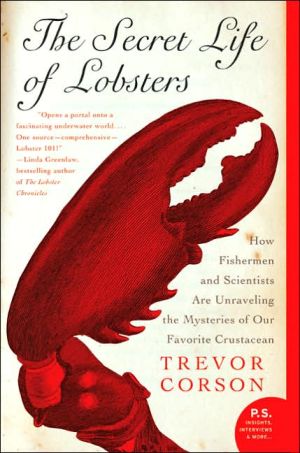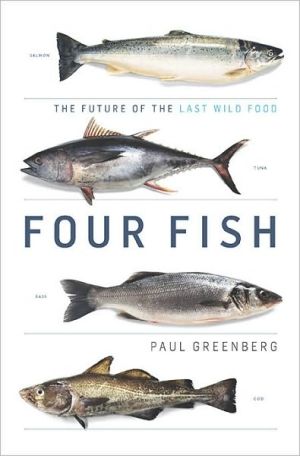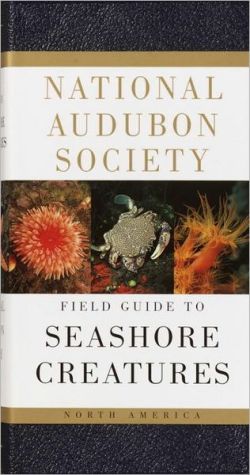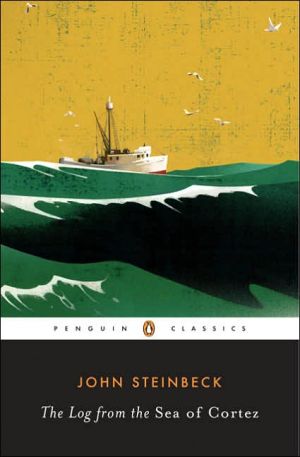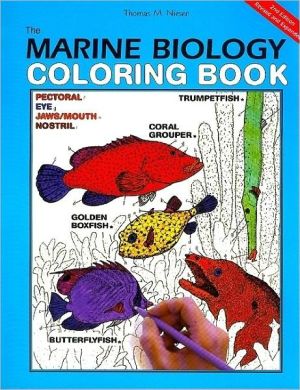Secret Life of Lobsters: How Fishermen and Scientists Are Unraveling the Mysteries of Our Favorite Crustacean
In this intimate portrait of an island lobstering community and aneccentric band of renegade biologists, journalist Trevor Corson escorts the reader onto the slippery decks of fishing boats, through danger-filled scuba dives, and deep into the churning currents of the Gulf of Maine to learn about the secret undersea lives of lobsters.\ This P.S. edition features an extra 16 pages of insights into the book, including author interviews, recommended reading, and more.
Search in google:
In this intimate portrait of an island lobstering community and an eccentric band of renegade biologists, journalist Trevor Corson escorts the reader onto the slippery decks of fishing boats, through danger-filled scuba dives, and deep into the churning currents of the Gulf of Maine to learn about the secret undersea lives of lobsters.This P.S. edition features an extra 16 pages of insights into the book, including author interviews, recommended reading, and more. Publishers Weekly In the 1980s, the lobster population in the waters off the coast of Maine was declining, threatening disaster for the state's lobster fishing industry. Government scientists attributed the drop-off to overfishing and recommended raising the minimum legal size of lobsters that could be harvested. Lobstermen disagreed, contending that their longstanding practice of returning oversized lobsters to the sea as brood stock would take care of the problem. In this intriguing and entertaining book, Corson, a journalist who has reported on such diverse subjects as organ transplants and Chinese sweatshops, brings together the often conflicting worlds of commercial lobstermen and marine scientists, showing how the two sides joined forces and tried for 15 years to solve the mystery of why the lobsters were disappearing. He brings the story to life by concentrating on the lobstermen and their families who live in one Maine fishing community, Little Cranberry Island, and alternating narratives of their lives with accounts of the research of scientists who, obsessed with the curious life of lobsters, conduct experiments that are often as strange and complex as the lobsters themselves. Corson provides more information about the lobster's unusual anatomy, eating habits and sex life than most readers will probably want to know, but he makes it all fascinating, especially when he juxtaposes observations of human behavior and descriptions of the social life of lobsters. However, by the end of the book, the answer to the puzzle remains elusive. Agent, Stuart Krichevsky. (June) Copyright 2004 Reed Business Information.
Prologue: Setting Out, 20011Part 1Jrapping1A Haul of Heritage212Honey Holes31Part 2Mating3Scent of a Woman434The Man Show535Sex, Size, and Videotape66Part 3Fighting6Eviction Notice877Battle Lines1048The War of the Eggs1179Claw Lock128Part 4Surviving10The Superlobsters14111Attack of the Killer Fish15512Kindergarten Cops172Part 5Sensing13See No Evil18914Against the Wind200Part 6Brooding15Gathering the Flock21116Victory Dance22417Fickle Seas237Epilogue: Hauling In, 2001259AppendixHow to Cook a Lobster273Author's Note279Further Reading283Acknowledgments285
\ From Barnes & NobleBarnes & Noble Discover Great New Writers\ Until now, the only thought our Discover readers had given to this species was how to get them to the pot of boiling water while avoiding their snapping pincers and flapping tails. With his first book, Trevor Corson has changed all that. For Corson has composed an elegant and intriguing work comprising three essential ingredients: natural history, biological research, and a loving portrait of a community. \ Corson, who spent two years working aboard a commercial lobster boat, also trolls alongside scientists who study the valuable crustaceans, offering intimate depictions of their work. And he introduces readers to generations of lobstermen and their families on Little Cranberry Island, a tiny fishing community off the coast of Maine. The end result of his assiduous detective work is this remarkable account of the delicate balance between these players and their role in ensuring the responsible stewardship of the lobster population as well as the survival of a storied industry. Along the way, Corson reveals lobsters as tremendously complex and interesting creatures: gentle, and at times, amorous lovers, as well as pugnacious and lethal bullies who regularly compete for dominance beneath the ocean's surface. Corson's passion for creatures we most often see accompanied by drawn butter is evident on every page of this wonderfully irresistible book. Bib not included. (Fall 2004 Selection)\ \ \ \ \ \ Time Out New York"Ultimately, this investigation into society, science and sustainability leaves a complex, satisfying taste in your mouth"\ \ \ Natural History magazine“I can highly recommend this book as one of the best things you can enjoy without melted butter.”\ \ \ \ \ Natural History Magazine"I can highly recommend this book as one of the best things you can enjoy without melted butter."\ \ \ \ \ Publishers WeeklyIn the 1980s, the lobster population in the waters off the coast of Maine was declining, threatening disaster for the state's lobster fishing industry. Government scientists attributed the drop-off to overfishing and recommended raising the minimum legal size of lobsters that could be harvested. Lobstermen disagreed, contending that their longstanding practice of returning oversized lobsters to the sea as brood stock would take care of the problem. In this intriguing and entertaining book, Corson, a journalist who has reported on such diverse subjects as organ transplants and Chinese sweatshops, brings together the often conflicting worlds of commercial lobstermen and marine scientists, showing how the two sides joined forces and tried for 15 years to solve the mystery of why the lobsters were disappearing. He brings the story to life by concentrating on the lobstermen and their families who live in one Maine fishing community, Little Cranberry Island, and alternating narratives of their lives with accounts of the research of scientists who, obsessed with the curious life of lobsters, conduct experiments that are often as strange and complex as the lobsters themselves. Corson provides more information about the lobster's unusual anatomy, eating habits and sex life than most readers will probably want to know, but he makes it all fascinating, especially when he juxtaposes observations of human behavior and descriptions of the social life of lobsters. However, by the end of the book, the answer to the puzzle remains elusive. Agent, Stuart Krichevsky. (June) Copyright 2004 Reed Business Information.\ \ \ \ \ Kirkus ReviewsA close-up look at the Maine lobster fishery and at the feisty crustaceans on which it's based. Boston-based journalist Corson focuses on a small community of lobstermen (and, of late, women) on Little Cranberry Island, in the Gulf of Maine. He follows them out to the hunting grounds on their boats, describes their traps and the onboard routine of baiting, setting, and emptying the huge wire cages. Working the same grounds as their grandfathers, the lobstermen face daily hostile elements and back-breaking work. Their prey, familiar on dinner plates around the world, was until recently one of the least understood creatures in the ocean. Scientists had determined that lobsters' sense of smell was highly developed, and assumed that female lobsters used their pheromones to lure the males of the species to mate with them. Only when a mixed group of captive lobsters was assembled in artificial habitats similar to those in the wild did the scientists discover that the males stayed at home and the females came to woo them. One female lobster after another would take up housekeeping with the dominant male, stay until she was impregnated, then make place for one of her sisters. Each female could carry hundreds of thousands of eggs on her tail. Lobster fishermen, who followed the practice of returning pregnant females to the water, assumed that the population was in little danger of overfishing; government scientists assumed the worst, and pushed for tighter restrictions on the size of lobsters that could be kept. Corson follows the fishermen and the maverick scientists who took their side in the dispute, along the way providing as complete a course in the lives of both lobsters and lobstermen asanyone could wish. Charmingly written, full of fascinating detail: a delight. Agent: Stuart Krichevsky/Stuart Krichevsky Agency\ \
